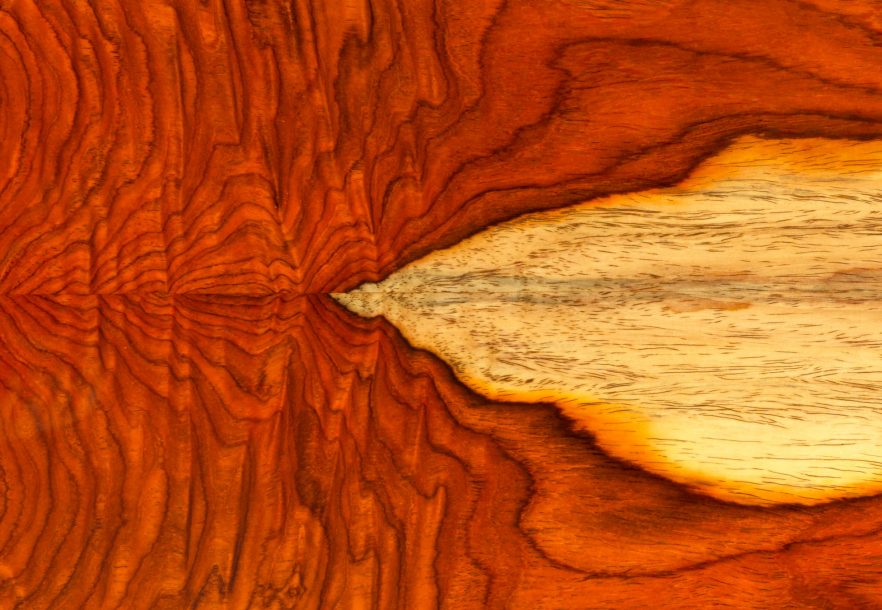
A quick look around the offering of acoustic guitars on the market will clearly show the popularity of alternative tonewoods. Species like koa, ziricote, and cocobolo aren’t just for inlays anymore. They’re strutting their stuff on some terrific instruments’ tops, backs, and sides. These woods might not dethrone spruce, mahogany, and rosewood (read more about the most mainstream guitar tonewoods) as the go-to options for acoustic guitars. Still, if you give them a shot, you’ll find they offer a list of their own sonic and aesthetic benefits.
Here we’ll look at five of our favorite ‘alternative’ tonewood options.
Don’t worry; we still love Myrtlewood. That’s why we gave it its own article that you can read here. But this one’s all about the stunning looks and sounds of these other acoustic guitar gems.
Western Red Cedar
Cedar has been an extremely popular tonewood for acoustic guitars since finding its way onto some of history’s finest classical and flamenco instruments in the 1800s. Though spruce was always in play, famed luthiers, such as Antonio de Torres, also utilized cedar for its mellower, responsive character. Today, cedar is still the second most used tonewood for acoustic guitar tops and a mainstay on guitars like our Pursuit Exotic S Concert Nylon CE.
Tonally, spruce and cedar share some things in common. They’re both articulate and deliver plenty of low-end. But cedar sets itself apart in how it does it. A softer tonewood than spruce, its lows are warmer and inviting. It also rounds off the treble, which is the secret to its mellow nature. Finally, cedar is famous for its effortless response to your touch and for highlighting the detail in your technique.
Koa
Koa is enjoying a ton of popularity right now, and it’s easy to see why. The wood’s natural golden-brown hues shimmer in the light, while figured pieces add a 3-dimensional quality to the experience. Though native to the Hawaiian islands, koa shares many similarities with Oregon’s own Myrtlewood; you’ll only find it in a small region, it grows along volcanic mountains, and it’s shaped by the salty sea air blowing off the Pacific.
Not as easy to work as some other tonewoods, for years, koa was usually used as the top layer in laminate acoustic guitars. It wasn’t until relatively recently that builders like Breedlove could create stunning, all-solid construction instruments – like this 30th Anniversary King Koa Concert Ce – from the material. Its sound can be described as focused and ringing. Though the wood has plenty of bass and treble, its midrange voice is its trademark, easily punching through acoustic ensembles.
(Sinker) Redwood
You’ve probably heard of Northern California’s legendary Redwood Forest and the colossal trees that give it its name. What you might not know is that redwood is a fantastic tonewood. Of course, we would never take part in clear-cutting any of these gentle giants. That’s why we find the redwood used on guitars like the Legacy Concert CE at the bottom of lakes and the ocean. These oxygen-free environments preserve the tonewood and create a darker, striped appearance, making the wood lighter and stiffer, perfect for acoustic guitar tops.
Sinker redwood’s voice is a cross between spruce and cedar. It’s both nuanced and bold simultaneously, delivering every detail of your performance with a clear, bold character. Unsurprisingly, it’s a favorite of fingerstyle players who appreciate precisely that.
Cocobolo
Cocobolo is a popular alternative to Brazilian rosewood. It even looks similar, albeit with a different palette of colors. Instead of rosewood’s chocolatey browns, cocobolo radiates a mix of oranges, reds, and yellows. Often swirling together, this tonewood makes for a showpiece any collector would dream of owning.
But cocobolo’s beauty is far from skin deep. While making it difficult to work, the wood is extremely hard, resulting in seemingly endless sustain and volume. Much like Brazilian rosewood, each note rings out, full of harmonic content, supported by powerful bass and pleasing treble. So, if you’re looking for a stunning-looking acoustic with a loud and responsive voice, check out a guitar like the cocobolo-backed Legacy Concertina Natural Shadow CE.
Ziracote
Much of what can be said about cocobolo can also be repeated here. Ziricote is breathtaking to behold, whether playing or simply staring at it. It is also in the same sonic family as Brazilian rosewood. But Ziricote’s black lines, creamy swirls, and darker, ghost-like greys are like nothing else. See for yourself on one of our 30th Anniversary Pheonix Concert Es.
The most powerful-sounding of the three cousins, ziricote is famous for its rich, booming low frequencies and bell-like top-end. It’s even been said to have its own reverb that “surrounds both player and audience,” making it a favored tonewood of classical, baroque, and flamenco guitarists.
